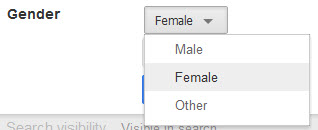With the development and use of the Internet, structural inequality in society has more or less affected the development of the Internet. For example, the most obvious structural inequality includes the inequality of race and gender, which leads to online hate speech about race and gender affecting the Internet’s regulatory issues. Race and gender are also important variables that affect the development of the Internet, and the resulting “digital divide” also affects the direction of Internet development. The development of the Internet has also affected these structural inequalities. The search discrimination on Google and the algorithmic bias of the Internet have increased the inequality of race and gender to some extent. Nevertheless, a series of online campaigns carried out on the Internet, such as #Metoo, have also contributed to improving structural inequality.

“Gender Menu on Google+” by tengrrl is licensed under CC BY-SA 2.0
Internet supervision and digital divide
Internet development has become an indispensable part of daily life. The Internet has changed the daily life of people, and it is impossible to influence structural inequality in society. The most obvious structural inequality such as race and gender. equality. The information on the Internet is always controlled by the mainstream group, while the status of colored and women on the Internet is always controlled by the mainstream group. There is a variety of exchanges around political, cultural launches, which are also flooded in these exchanges and all kinds of hate speech, racial discrimination, gender discrimination, and online harassment (Flew, 2019, p97). The emergence of these remarks is closely related to the structural inequality of race and gender, and structural unequal affects the direction of public opinion on the Internet. With a variety of hate speech, racial discrimination, gender discrimination content on the Internet, the rights and responsibility issues, increasing the difficulty of the digital media platform for content. Because all major social platforms need to be responsible for users, if the spread of these hate speech will make social marginalization groups more marginalized, the current situation of social media platforms is one of the important issues facing the development of the Internet.
Structural inequality not only affects the monitoring of the Internet but in the early days of the development of the Internet, race is an important variable as predictive computer access and use. For example, in the United States, African Americans are lower than whites with and using computer equipment. Similarly, the survey showed that in many developing countries, women’s online network rates were significantly lower than that of males (Daniels,2013,p696). This digital divide from race and gender is affected to varying degrees of development of the Internet in the world.
Social structural inequality reproduces on the Internet
The development and operation of the Internet may exacerbate inequality of race and gender in some ways. The Internet does not provide an escape from racism and gender discrimination, but they continue to exist on the network platform in terms of the internet, and there is a ring on the network (Daniels,2013,pp.697-698). Displaying discrimination against gender and race on the Google search engine is practical on the Internet. Because the ranking of the search engine is the “mirror” of the user’s idea, the society has always existed racial discrimination and gender discrimination, and Google’s users completely presented this discrimination on search engines. In Google’s erotic search, black women have always ranked most, such results show the lack of women in history and contemporary society in a direct manner (Noble, 2018,p16). Most intuitively, in the most intuitive manner, the internet technology is presented to all Google users, so that the marginal groups of races and gender are more marginalized on the network. These search rankings are undoubtedly increasingly misunderstandings for black women. bias. Social Media Platform companies are also heavy, and monopoly companies like Google are capable of controlling search ranking, but search rankings often show most of the interest of most mainstream users, and the user’s interests determine the interests of the platform. . Social media platforms will only delete and interfere with illegal content, but there are no restrictions on racism and gender discrimination. In this case, it has created more inequalities for race and gender like Google (Noble, 2018,pp.17-18).
There is also an algorithm prejudice based on racial discrimination and gender discrimination presentation. For example, artificial intelligence is based on ethnic predictions, causing black defendants to be overprinted in court, and predicting white criminals will not make mistakes again (Noble, 2018,pp.17-18). These algorithms and automation decisions that are presented on the Internet are created by humans.
In addition, According to Noble (2018)male gazing also continues to show on the Internet, male stares women as marginalized products, such as online advertising and game propaganda pages, are built to attract men’s viewing, female image Following the aesthetics of men to please male users. Because for the Internet, the ideal user is always considered to be male, while women serve as men’s accessories in traditional society, and the image on the Internet will naturally exist to please men. For black women’s erotic gaze, there is also an embodiment of race and gender inequality on the Internet.
Online Activism breaks the regional limit
Although certain aspects of the Internet increase structural inequality in society and make marginalized groups more marginalized under the control of mainstream groups, certain aspects of the Internet also help to improve structural inequality, such as the Internet Provide a common platform for marginalized groups. The development of social media platforms provides a voice platform for marginalized minorities. After centuries of silence, Internet users around the world can now hear their voices (Temkit & St Lewis,2019,pp.3-6). The survey shows that people of color have higher participation on social media platforms than whites because, for people of color, they are disadvantaged and marginalized minorities in society, but the Internet provides them with a platform for them to gather together, according to Temkit & St Lewis (2019), creating content on social media is a way of ethnic self-expression for people of color. Social media enables people of the same ethnic background to connect, thereby providing them with a way to express and explore their racial identity. Safe space.
In recent years, there have been a large number of campaigns against social structural inequality on the Internet. Take the most famous #MeToo campaign as an example, encouraging all women who have been sexually assaulted and harassed to speak up on Twitter. Before that, it was difficult for women to speak up for themselves when they were sexually assaulted. It was the women who were often accused of being assaulted, and society told women to remain silent. As the #MeToo movement developed on the Internet to all areas of society, more and more girls who were violated posted their experiences on the Internet, social media provided them with a platform to speak out, and they all became brave “silence breakers” “. There are three main reasons why these movements can break geographical boundaries on the Internet and reach a wider audience. First, social media platforms allow rapid information exchange and cross-regional dissemination. Second, the Internet allows users to generate and express their opinions. Third, the Internet allows interaction between users (Xiong, Cho& Boatwright,2019,pp.11-12). Under these characteristics, the Internet provides a platform for women and people of color to initiate resistance movements to share their own experiences. The Internet can easily bring these people with the same experience together, and the Internet can bring their “voices” together. Spread to the world. Large-scale feminist movements like #MeToo have not only reduced online harassment to a large extent but also reduced and improved the sexual harassment and sexual assault on women in real life, thereby promoting gender equality.
The Internet and social structural inequality affect each other, and the regulatory issues and digital divide brought about by gender and race inequality on the Internet have affected the development direction of the Internet. The impact of the Internet on structural inequality has also brought different results from different aspects. The Internet has reproduced social structural inequality to some extent, such as Google search discrimination against women and people of color, digital technology Algorithmic bias, and the male gaze in online advertising. However, on the other hand, the development of the Internet has provided a platform for marginalized groups of race and gender to speak out for them. The characteristics of the Internet allow them to gather together and break the boundaries of regions and races. In general, the Internet still needs more political intervention and supervision to ensure its future development direction.
Reference
Daniels, J. (2013). Race and racism in Internet Studies: A review and critique. New Media & Society, 15(5), 695–719. https://doi.org/10.1177/1461444812462849
Flew, T. (2019). Guarding the gatekeepers: Trust, truth and digital platforms. Griffith Review, 64, 94-103.
Noble, S. U. (2018). Algorithms of oppression. New York University Press.
Temkit, M., & St Lewis, J. (2019). Online Activism as a Tool for Anti-Racist Social Change.
Xiong, Y., Cho, M., & Boatwright, B. (2019). Hashtag activism and message frames among social movement organizations: Semantic network analysis and thematic analysis of Twitter during the# MeToo movement. Public relations review, 45(1), 10-23.


